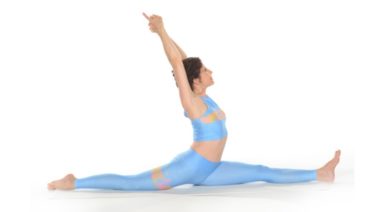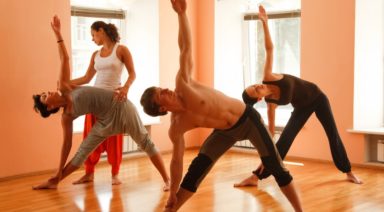10 Tips for Body Confidence in the Bedroom

Whether you’ve been with your partner three times or 300 times, had two dates or 20, getting naked in front of another can be a conflict-ridden experience. Heck, getting naked in front of a mirror can be a conflict-ridden experience. We may try to convince our partner that sex is more intimate with the lights off, or more novel with our dress still on, or that we don’t want to go on top for reasons other than our tummy. Sure, it’s one thing to feel confident in a flattering outfit. It’s another to be confident in lingerie or in the buff. Well, if you’re practicing yoga, you’re off to a good start: Several studies have shown that people who have a regular yoga practice are less likely to struggle with body-image issues and disordered eating; they are less likely to participate in what researchers call self-objectification; and they are more likely to feel connected to and confident with their bodies. So get bendy! And if you’re still feeling shy about rocking your birthday suit in front of your lucky lover, here are 10 more tips for doing it with the lights on:
1. Focus on ability and functionality, rather than appearance. If you’re able-bodied, practice gratitude for that. Think about how incredible it is that we are these biomechanical beings that can bend and run and dance and strut. Now dance and strut!
2. Do number 1. To empowering music. In front of a mirror. Naked.
**3. Three things: Exfoliate, moisturize, bronze. **All-natural and organic, of course. Healthy glow=good. Carcinogens=bad.
4. Find clothes that fit and flatter. Remember, no one can tell what size you’re wearing, but they likely can tell if you’re squeezed into something too small for you. If you anticipate losing weight, you can always get smaller garments in a few months.
**5. Befriend your soft spots. **You have two options: You can despise, detest, and reject your soft spots, your less-than perfect breasts, and your sagging skin; or, you can embrace the imperfections. You change the word “fat” from an adjective to a noun. You can recognize the vital role it plays in your health, comfort, and fertility. You can thank it for allowing you to sit without pain, and you can thank your body for being so efficient at holding onto calories (survival of the fittest! What did you think “fit” meant?). You can smile at your wrinkles, stretch marks, moles and scars, and think about the stories each would tell if it could talk.
6. Let go of expectation and pretend you know what you’re doing. Your partner can only read you from what he or she sees (and as far as they’re concerned, you’re the furthest thing from underconfident). As the saying goes, “Fake it ‘til you make it.”
7. Remind yourself that the models, actors and people in the media who set the standard are not the norm. That is their career. Their income is based on achieving and maintaining a freakishly “perfect” (by western standards) appearance. That is not the rest of the world’s job. It’s probably not your job. So take some of that pressure off. Phew.
8. Anxiety comes from uncertainty. Experience and familiarity builds confidence. Lock the door, turn up the heat, and spend some quality time doing everything in your house/apartment naked. Just make sure the blinds are closed, first, and warn your roommate, or else they might think you’ve lost it. Oh, and maybe avoid opening pickle jars in front your partner in the beginning (Seinfeld, anyone? No?). Want to really dive into your fear? Sign up to be a nude model for an art class. Now THAT’S exposure therapy!
9. Your partner probably isn’t Ryan Gosling (and if he is please ask him why he won’t return my calls). But seriously, they have their imperfections, too. If that doesn’t seem apparent, physically, know that they still have insecurities about parts of themselves, physical, emotional, mental—everyone does. Some are just better at self-acceptance than others.
10. Your lucky partner is pumped to be there. Let me ask you this: When in the history of ever has one partner watched the other disrobe then said, “Sorry. I actually don’t want to have sex with you, now. I expected you to look different underneath your clothes”? My point exactly. If you’ve gotten to the point where you’re going to be naked in front of the privileged other, they’re going to be far more turned off by your distracted attempts to contort yourself into a flattering position or refusal to be anywhere but concealed under several blankets. The hard part’s over! Now have some (safe) fun!
Nada Yoga: The Yoga of Sound

The first time I went to India, little did I know that my life was going to completely change. I know, many people come back from India saying they transformed. It happened to me, too.
At that time, I was a singing student at the university in Montreal and was feeling blocked. My voice was weak and so was my morale. I heard that in India, before a concert, a singer would sometimes sing ‘om’ for almost one hour, reconnecting to their soul, before starting the performance. I became very intrigued. “Maybe I could also find a way to reconnect to my voice?” I thought to myself. I bought my airplane ticket and suspended my university studies for one semester.
I didn’t know where to go; India is huge! However, a whole series of coincidences brought me to my teachers and I started my journey. In my first class, one of them asked me to sing an “A” sound, which I did. He listened. After a few moments of silence, he said “You are not connected to your voice.” I smiled, as I thought to myself: “That is exactly why I came. I must be in the right place.”
That was the beginning of a fascinating adventure and my initiation into the Nada yoga tradition. I had no idea at the time that I would be touched in the depths of my soul, healed in places I didn’t even know needed healing. After a few months of studying with them, I came back home, and my voice was transformed and my career shifted unexpectedly. Above all, I came back humbled. Now, I spend half the year, every year since, studying in that country, deepening in this path and sharing this knowledge with people in the West.
What is Nada Yoga ?
Nada, from the Sanskrit “नाद”, means “sound”. Nada Yoga is the yoga of sound.
There are different ways in which you can explore sound on your yoga journey. While some Nada Yoga practices have been well documented and are mentioned in the sacred texts, other practices have only been passed from generation to generation, mostly as oral traditions.
Russill Paul is a contemporary Nada yogi who has written extensively on the subject, and who suggests a classification of four different branches of Nada Yoga. While this classification is not official, it helps explain the different aspects of this form of yoga.
Shabd and Shakti
The first two branches are called, according to Paul, Shabd Yoga and Shakti Yoga. Both focus on mantras and their mystical properties, but their origins and ways of practicing differ.
Bhakti
The third branch is called Bhakti Yoga. Bhakti means devotion. Bhakti Yoga is all about chanting devotional songs to connect to a space of grace.
Nada
The fourth branch of Nada Yoga, according to Russill Paul, is also called Nada Yoga. It uses pure sounds as a means of meditation. There are no mantras involved.
The last branch – the one in which I am specializing – overlaps with classical Indian music. Classical Indian music is a very complex, refined tradition. It is a deeply mystical art form, and although one can study this music without exploring Nada Yoga, one finds that the Nada Yoga journey lies at the very core of this art. So, a musician can develop a Nada Yoga sadhana (spiritual practice) along with their musical development.
Of course, it is not necessary to be a professional musician to benefit from these practices. I have taught Nada Yoga classes and workshops to people from varied backgrounds, and found we all can benefit greatly from it. Ultimately, this is not just an exotic form of yoga.
Nada yoga is about you and how you relate to yourself, how you inhabit your body, how you align your mind, how you express your soul.
Let me give you a taste of it. Since I’m specializing in the fourth branch mentioned above, and more specifically on voice, I will share with you a vocal exercise from that branch.
Aakar: A Singing Practice
Take a moment now. Sit in a comfortable position, ideally with the back straight. As you are reading this text, take a deep breath and scan your body: is there any tension anywhere? See if you can become a bit more aligned, a bit more relaxed in your posture. Take your time.
When you feel ready, take another deep breath, and let a simple /a:/ sound come, as in the word “spa”.
Listen to yourself as you sing this tone. Pay as much attention to the act of emitting a sound as to the act of listening to it.
Now, check in with yourself: are you afraid of expressing this sound? If yes, then see how it feels to take your space a bit more. Don’t force yourself to open up all at once. Just gently explore the possibility of taking more space around you with your voice.
Are you feeling tense, anxious? Can you hear that in your voice as well? Just observe and listen. Is your voice shaking? Let it shake. Do you feel frustrated that it is shaking? Let frustration be. Does it feel stuck? Let it be stuck. Discover the relief of allowing yourself to be, just as you are, right now.
So often in our lives we have to compromise, adjust, refrain, etc. But here you have an opportunity to create an inner temple for yourself. Give space to for your voice to be exactly as it is. Receive and give space to whatever comes up. But in your mind, remain focused, aware and equanimous. As you keep this neutral witnessing quality, you will notice that your voice will gradually settle down, open up and naturally realign itself.
Observe the Body
Continue breathing deeply, and calmly singing your “A” on the exhalations. Then, observe the body.
Keep watching your posture, so that it is aligned and keep listening to yourself. See if you can let your body become more open and relaxed, but not so relaxed that your sound becomes feeble. Find balance between tonus and relaxation. Look for that middle point. Now look at your shoulders, your neck. Necks tend to tense, especially when singing. See if you can relax that region.
Scan your chest, your face, your jaw, your eyes; bring release to these parts, too. Observe your belly and your hip area: these are areas where we often hold tension. Sing your ‘A’s as you focus respectively on each area, and bring some deeper tonus and relaxation to them. In more advanced states of practice, we can actually bring the sound vibrations to different parts of the body, but for now, let’s just focus on them, letting your voice open up as your body realigns itself.
As you explore this practice you will notice your mind wandering again and again. Bring it back, again and again. My teacher said something one time that I never forgot: “Mental power has to be developed gradually. It is not a matter of one to two hours, or one to two weeks… or even one to two years. Mental power has to be developed over a long time. What is mental power? The power to focus.”
So use this exercise as an opportunity to develop that. You will find that as you develop it, you start to reach deeper levels of perception, insight and peacefulness. It will also allow you to access deeper levels of the practice and open your voice even further.
As your mind settles you begin shining presence on your vocal expression, and it starts to transform. Imagine a channel that has been clogged for a long time. Once you pass some water through it, gently, over and over, slowly it starts to unclog. Likewise, your voice, totally welcomed as it is, united with your conscious presence and aligned posture and breath, becomes like water to your system. Slowly you are unblocking your inner pipe; you are realigning your system. With this exercise, you are peeling away, gradually, all these layers of subconscious blockages that we all carry around.
Much more could be said about Aakar practice, but this is a good introduction. If you are new to singing, practice up to 30 minutes at a time, as your vocal cords might get tired if you practice longer. Drinking water throughout your practice is also recommended to keep your throat hydrated. Now remember, breath work, body alignment and mental focus are the key aspects here. Without these the “yoga” aspect of this practice is gone.
Aakar can be very simple at first sight, but you might discover tremendous depth in it. It is one of the main exercises we do in the tradition I am studying. For in-depth work, it is recommended that you have an assisted practice, so that you can understand all the different ways in which you, personally (and often unconsciously), block your voice. But with this simple written explanation you can already benefit a lot.
The Power of Your Voice
Voice is such a great tool to guide us in our life quest, because it is a very loyal mirror of our inner reality. Our voices change every day, depending on how we feel, and how our bodies and minds are. In ancient traditional medicine systems, such as Traditional Chinese Medicine (TCM) or Ayurveda, voice has been used as a tool of diagnosis. Just by listening to the voice the doctor can get information about the patient’s overall health condition.
We also can make the best use of this amazing tool, not only as a means of diagnosis like in these medicinal traditions, but as a guide to liberation. We can let our voices guide us into deeper alignment, emotional release, reconnection to our essence, mental clarity and inner peace.
It has been scientifically proven that the whole universe is made of vibrations. The ancient Indian scriptures actually affirm that the universe was created by sound. As you experiment with different Nada Yoga practices, maybe you will also find that sound is indeed a powerful doorway into the Great Mystery.
I wish you all happy explorations in your yoga journey.




































